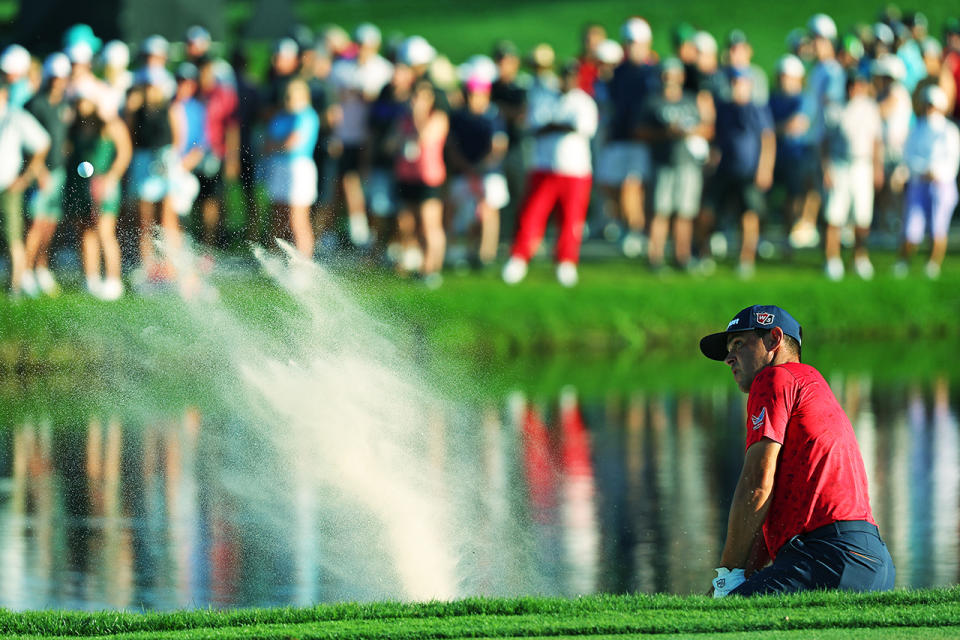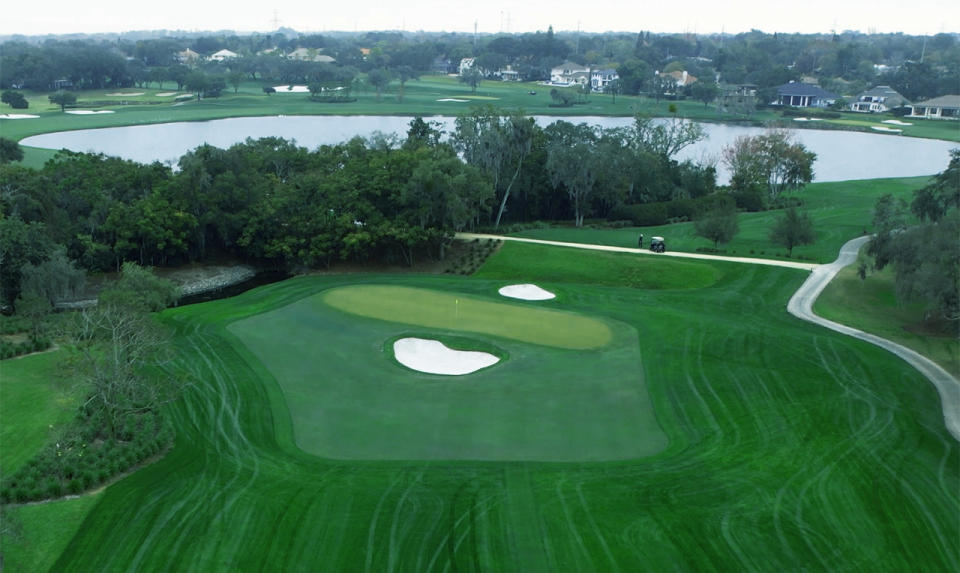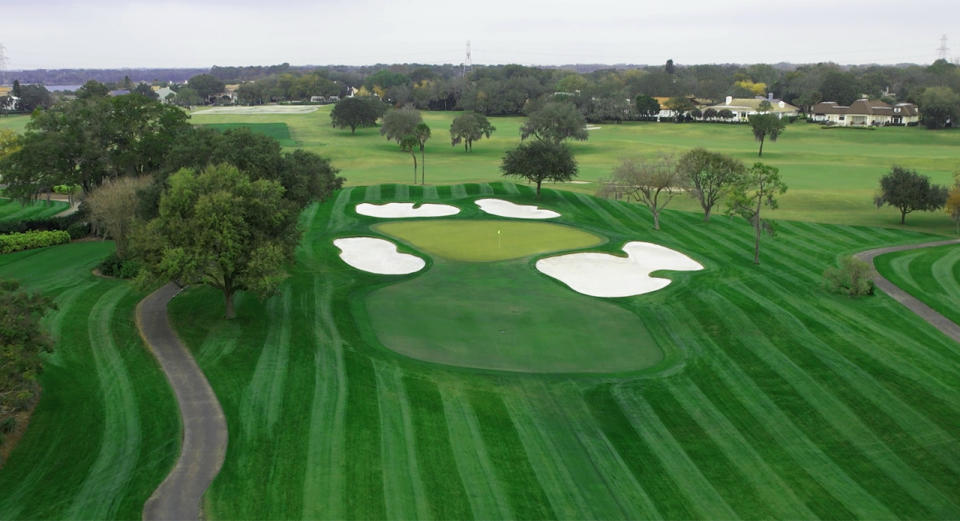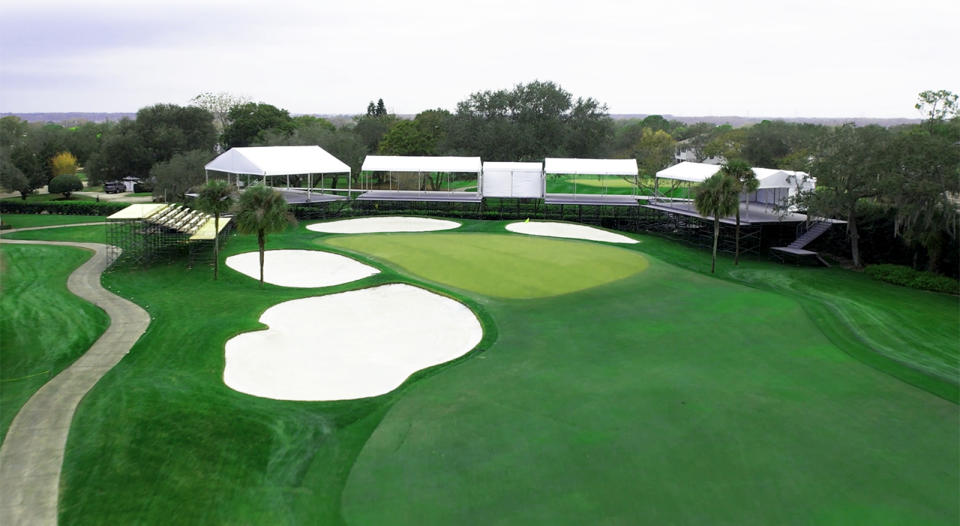Bay Hill’s par 3s might be the toughest on Tour (and they have a huge impact on the Arnold Palmer Invitational)

Gary Woodland, winner of the 2019 U.S. Open, has some advice for players in the Arnold Palmer Invitational presented by Mastercard: Watch your step on the par 3s at Bay Hill Club & Lodge.
In last year’s event Woodland arrived at the downhill, over-the-water par-3 17th on Sunday with a one-shot lead at 6 under par for the week, having just made eagle on the par-5 16th. One more good swing, one more good result, and Woodland would have a chance play the famed par-4 18th with a lead in pursuit of his first title at Bay Hill.
Things didn’t work out. Woodland’s 8-iron approach to the back-right hole location – a small target tucked between sand, water and rough – fell short of the green, clearing the pond but plugging into the front bunker. It took him two swipes to get out of the sand, and the ensuing double bogey left him a shot behind eventual winner Scottie Scheffler. A following bogey on 18 added salt to the wound, dropping him to a tie for fifth place.
It was a painful example of how tough the par 3s play at Bay Hill. The four holes – Nos. 2, 7, 14 and 17 – averaged the highest score over par among any set of pars 3s on the PGA Tour in the 2021-22 season in an official stroke-play individual event, not counting major championships. The Bay Hill quartet played to an average over-par score of 3.193 for the week, proving it’s not always the longest holes that trip up the best players in the world, but sometimes the shortest.
“Most of the time, the par 3s out here (on the PGA Tour), you’re trying to attack, trying to make some birdies,” Woodland said.
But not at Bay Hill.
“You really should play to the middle of the green on all four of them,” said the four-time PGA Tour winner. “… No. 2, when you’re trying to run away with par. No. 17, when you’re trying to run away with par.”

Gary Woodland took two shots to escape a buried lie in the bunker at the front of the 17th green in the final round of the 2022 Arnold Palmer Invitational at Bay Hill Club & Lodge in Orlando. (Kevin C. Cox/Getty Images)
The worst part for Woodland last year? He struck his tee shot on No. 17 exactly as he planned toward a more generous area of the green left of the flag. He said he isn’t sure if his ball was hit by a gust of wind or what, but there was plenty of frustration in coming up short.
Woodland wasn’t the only player in contention to lose traction Sunday on the 17th. Viktor Hovland was 5 under par for the week – which would have earned him a spot in a playoff – when he walked up the hill from the 16th green to the 17th tee. Four shots later, he was one behind. The Norwegian spoke later about how much “this one stings” after that bogey on 17 knocked him into a tie for second place.
“It’s just a brutal hole,” Woodland said. “You know where that pin’s gonna be: back right. They move the tee up and they kind of tempt you a little bit.”
As so often is the case, temptation leads to folly. Especially on the par 3s at Bay Hill. The layout is famous for its closing par-4 18th, with its green wrapped around a pond. The par-5 sixth has gained notoriety in recent years as well, with ever-longer players attempting eye-popping tee shots across the lake around which the hole is wrapped. But smart pros know to be wary of the one-shotters.
Looking again at last year’s event, it’s clear how important the par 3s are for players packed atop a tight leaderboard. Winner Scheffler played the par 3s for the week in 48 shots, which was even par in 16 attempts. Woodland required 50 total shots, playing them in 2 over, and he finished two shots back in the end. Tyrrell Hatton, who also finished tied for second and one shot behind Scheffler, required 51 total strokes on the par 3s, playing them 3 over par for the week. And Hovland took 52 shots in all on the par 3s, playing them 4 over for the week. Each of those strokes mattered dearly on the final leaderboard.
That theme extended into the final round. Scheffler was 1 under on the par 3s Sunday, making birdie on No. 2 and parring the others. Hovland and Hatton were one shot worse, with both players even on the par 3s in the final round. Woodland played the pars 3s that day in 2 over par, with three pars and that double bogey on 17.
Book your trip to Bay Hill today
A tough quartet of par 3s

No. 2 at Bay Hill Club and Lodge in Orlando, site of the Arnold Palmer Invitational (Gabe Gudgel/Golfweek)
Weekend warriors often think of par 3s as the easiest holes they play. It only takes one good swing to reach the green in regulation, whereas par 4s typically require two good swings and par 5s typically require three solid shots for most amateur players. On the PGA Tour, that isn’t the case, especially at the toughest tournaments as many par 3s are stretched beyond 200 yards. Count Bay Hill among those.
In 2022, three of the annual major championships – the Masters at Augusta National Golf Club (3.255), the PGA Championship at Southern Hills Country Club (3.228) and the U.S. Open at the Country Club in Brookline, Massachusetts (3.202) – had sets of par 3s that played tougher than did those at Bay Hill. The British Open on the Old Course at St. Andrews – which has only two par 3s – was the one respite of sorts, with those two holes playing to a 3.151 average.
For the 2021-22 season, the par 3s on the PGA Tour played to a 3.068 average. Bay Hill, as mentioned, offered the toughest set of par 3s (3.193 average) not counting the majors. The Orlando layout’s par 3s were followed in resistance to scoring by those at Port Royal Golf Course in the Butterfield Bermuda Championship (3.190), PGA National Resort’s Champion Course for The Honda Classic (3.188) and The Renaissance Club for the Genesis Scottish Open (3.164).
By contrast, the lowest scores on a set of par 3s for the season came at El Camaleón Golf Course for the World Wide Technology Championship at Mayakoba in Mexico ( 2.833 average).
The par-72 Bay Hill, of course, is a tough challenge all around. Scheffler’s winning score of 5-under 283 was the highest four-round total on Tour for the 2021-22 season. Only the par-70 Southern Hills in the PGA Championship, won by Justin Thomas at 5-under 275, matched Bay Hill for fewest strokes under par by a winner.
And it’s not just the par 3s at Bay Hill. The average score on Bay Hill’s par 4s last year was 4.227, making them even tougher in relation to par the par 3s – that isn’t a surprise, seeing as how length, thick rough, wind, plenty of water and tricky putting surfaces confound the players each year in the Arnold Palmer Invitational presented by Mastercard. And as is typical at all PGA Tour events, the par 5s played the easiest in relation to par with a 4.715 average as players could reach some of those greens in two shots or lay back to set up wedge approaches.
So yes, the par 4s at Bay Hill are hard, even for the pros. That’s a given. But it’s the outsized impact of the par 3s that’s most surprising. A closer examination of each is in order.
The details on Bay Hill's par 3s
No. 2 is the longest of Bay Hill’s par 3s at 231 yards, playing to a green that climbs a hill beyond the putting surface. The 33-yard-deep green is angled away from the players from the front right to back left, and the surface is tilted sharply to the left. Players usually hit a long iron, a hybrid or sometimes even a fairway wood into the green. Any shot that lands on closely cut grass short or to the left likely rolls downhill, back and away from the putting surface. A bunker in the front catches plenty of shots and isn’t the worst place from which to play a second shot. A bunker just beyond the green is particularly nasty, leaving players a downhill blast. In 2022, this hole played to a 3.269 average, making it the toughest par 3 at Bay Hill.

No. 7 at Bay Hill Club and Lodge in Orlando, site of the Arnold Palmer Invitational (Gabe Gudgel/Golfweek)
No. 7 was the easiest – easiest being a relative term – of Bay Hill’s par 3s in 2022, playing to a 3.104 average. The 199-yard hole plays slightly uphill to a 28-yard-deep green guarded by four bunkers. The putting surface slopes severely from back to front, offering birdie chances to players who leave their approach shots beneath the hole but challenging anyone whose tee shot bounces beyond the flag with a sharply downhill putt.
No. 14, another uphiller that plays to 215 yards, also features four bunkers and has an open area short and right. As with No. 7, the 30-yard-deep green slopes from back to front, giving the best opportunities to players who keep the ball beneath the hole. In 2022, it played to a 3.173 average.
Then comes No. 17. The tee sits back in a grove of trees and plays downhill to a green on the opposite side of a pond. That elevated tee complicates matters in the frequent March winds of Central Florida, as players must calculate not only the drop to the putting surface but the exaggerated influence of any gusts as the ball descends. The hole is listed as 221 yards on the scorecard, but tournament officials sometimes move up the tee, as Woodland mentioned about Sunday last year. After crossing the water, a large bunker guards much of the green short. Two other bunkers, left and long, complicate matters. The green is angled away from the tee from the front left to the back right, and any approach to that back right area must be precisely judged. The 35-yard-deep green slopes from back to front with a ridge dividing the middle. The hole played to a 3.226 average in 2022.
Hitting any of these par-3 greens in regulation is an accomplishment, even for Tour pros. That’s especially true on Nos. 2 and 17. As Woodland said, it’s frequently best to aim for the middle of the greens, then putt for par from there. He would know.
“Take your medicine and get out of there,” he said.
– Adam Schupak contributed to this story
Hardest par 3s on the PGA Tour (non-majors)

No. 14 at Bay Hill Club and Lodge in Orlando, site of the Arnold Palmer Invitational (Gabe Gudgel/Golfweek)
Listed below are the 10 toughest sets of par 3s on the PGA Tour last year, with each tournament’s average score on those holes. Bay Hill’s par 3s ranked the toughest at any host course except three of the year’s major championships.
The Masters, Augusta National: 3.255
PGA Championship, Southern Hills: 3.228
U.S. Open, The Country Club: 3.202
Arnold Palmer Invitational, Bay Hill: 3.193
Butterfield Bermuda Championship, Port Royal: 3.190
Honda Classic, PGA National (Champion): 3.188
Genesis Scottish Open, Renaissance Club: 3.164
RBC Heritage, Harbour Town Golf Links: 3.156
Charles Schwab Challenge, Colonial: 3.154
British Open, St. Andrews (Old): 3.151
Strackaline yardage book: No. 2 at Bay Hill

The StrackaLine yardage book for Bay Hill Club and Lodge, site of the PGA Tour’s Arnold Palmer Invitational presented by Mastercard (Courtesy of StrackaLine)
Thanks to yardage books provided by StrackaLine – the maker of detailed yardage books for thousands of courses around the world – we can see exactly the challenges the pros face this week on the par 3s at Bay Hill. Keep scrolling for more.
Strackaline yardage book: No. 7 at Bay Hill

The StrackaLine yardage book for Bay Hill Club and Lodge, site of the PGA Tour’s Arnold Palmer Invitational presented by Mastercard (Courtesy of StrackaLine)
StrackaLine yardage book: No. 14 at Bay Hill

The StrackaLine yardage book for Bay Hill Club and Lodge, site of the PGA Tour’s Arnold Palmer Invitational presented by Mastercard (Courtesy of StrackaLine)
Strackaline yardage book: No. 17 at Bay Hill

The StrackaLine yardage book for Bay Hill Club and Lodge, site of the PGA Tour’s Arnold Palmer Invitational presented by Mastercard (Courtesy of StrackaLine)

